Different Kinds of Poker – Games and Variants
One reason poker is so popular is that there are so many different ways to play. There are several poker variations that can be combined in different ways.
You can also add variety to your poker experience by mixing up the forms of poker you play. That means trying both cash games and tournaments or even exploring casino poker games.
This page is your guide to all the different types of poker that are available. Keep reading to find out about the most popular poker variants and a few you may have never heard of.
After we explain the different forms of poker, we guide you through the process of choosing which one you want to play. We also recommend some of the top online poker sites.
Contents of Our Guide to Poker Games and Variants

Most Popular Poker Games
There are three main categories that poker games typically fall into. Understanding which of these categories a particular type of poker game falls into will help you understand the basis of the game.

The Three Main Types of Poker Games
- Draw poker allows players to improve their hands by replacing a certain number of cards.
- Stud poker variations force players to expose some of their cards. This gives their opponents information about the hand.
- Community card poker is when players combine their hidden cards with the shared community cards to create the best hand.
We will explain each of these categories further as we explore the most popular types of poker.
Texas Hold ‘Em

Texas Hold ‘Em is undoubtedly one of the most popular poker games today. The combined rise of both online and televised poker has led to an explosion of new players who want to play Hold ‘Em.
Another reason Texas Hold ‘Em is so popular is that it is surprisingly easy to learn. If you are a beginner poker player, Hold ‘Em is definitely the best place to start.
The objective of Texas Hold ‘Em is to either have or convince your opponents that you have the best five-card poker hand. You will get two hidden cards, and five cards are dealt as community cards.
There are four betting rounds, or streets, in Texas Hold ‘Em. They are pre-flop, the flop, the turn, and the river. You will have a chance to bet or fold during each betting round.
- Pre-flop is before any of the community cards get dealt. Your pre-flop actions are based only on the two cards that get dealt to you.
- The flop refers to the first three community cards. After the dealer “burns” a card, they will deal the next three cards face up in the middle of the table. You act after seeing the flop.
- The turn is the fourth card that gets added to the community cards. Again, the dealer will burn a card first and then deal the next one.
- Finally, the dealer will deal the river. The final betting round occurs after the last card has been dealt.
Once the river betting round is over, the remaining players will reveal their cards. Whoever had the highest five-card poker hand will win. If only one player didn’t fold, they don’t have to reveal their cards.
That is a simple introduction to Texas Hold ‘Em. Before you start playing, you need to understand a little more about the betting rules and some strategy tips.
Our Texas Hold ‘Em guide explains everything else you need to know about this exciting community card poker variant.
Omaha
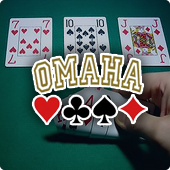
Omaha is another community card poker game. The official name is Omaha Hold ‘Em, but most players just call it Omaha or Omaha High.
There is one primary distinction between Texas Hold ‘Em and Omaha. When you play Omaha, you get dealt four cards instead of two.
You have to use two of those cards to make your poker hand, and you cannot use any more than two of them.
Because of this rule, the hand you think you will play pre-flop may change drastically during the flop, turn, and river.
It also affects your strategy decisions. For example, a pair of jacks or queens is a solid starting hand in Texas Hold ‘Em, but they are not nearly as valuable when you play Omaha.
Check out our guide to Omaha Poker to find out some excellent strategies for playing Omaha.
Our Omaha guide also explains more about the multiple ways to play Omaha. Pot-limit or fixed limit formats of poker have different betting strategies than the no-limit game.
You can also play Omaha Hi/Lo. It is a split-pot game where the pot gets split between the highest and lowest hand at the table.
The only way to win the whole pot is to be the player with both the highest and lowest hands. Omaha Hi/Lo can be played with a qualifying hand, known as Omaha 8, or no qualifying hand.
Seven-Card Stud
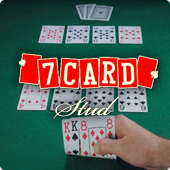
Seven-card stud is the first stud poker variant we will explain. This variant has been around since the Civil War, and it was specifically popular with the US military for many decades.
Each player starts with seven cards, which is where the game gets its name. Only eight players can play at a time because a standard 52-card deck cannot accommodate more players.
The game begins with every player posting an ante bet, usually between 10-25% of the first betting limit. Then, the dealer will begin by giving every player two cards face-down and one card face-up.
Whichever player has the lowest face-up card has to play the bring-in bet. Aces are high in seven-card stud, so the lowest possible card is a 2.
If there are two players with the same low card, the suit will determine which player has to play the bring-in.
The suits are valued in alphabetical order from low to high.
- Clubs (Lowest suit)
- Diamonds
- Hearts
- Spades (Highest suit)
The bring-in bet starts the first betting round. Every player will have a chance to fold or bet to continue the hand. Then, the dealer will deal another face-up card to each player.
Whichever player has the strongest hand showing will be the first to bet for each round. That means the first player to bet changes for each betting round.
This pattern continues for the fifth and sixth cards that get dealt. Finally, the seventh card will be dealt face-down.
At that point, you will have four cards face-up and three face-down. You have to make the best five-card hand from those seven cards. There are no community cards to help you unless the deck ran out of cards.
As you can see, seven-card stud is very different from community poker variants. It is almost always played with fixed limits or a pot limit. You can learn more about playing seven-card stud from our guide.
Razz

Razz is an unusual poker variant because it is not typically played on its own.
It makes up the “R” in mixed-poker games, such as HORSE. So, most players play Razz only when they are playing a mixed game.
If you have played seven-card stud, it won’t be difficult to grasp Razz because it follows the same structure.
Players place an ante and then receive two cards face-down and one card face-up. The betting rounds and deals follow the same pattern as seven-card stud.
There is one primary difference between Razz and seven-card stud. Razz is a lowball game, which means the player with the lowest hand wins.
Therefore, the player with the highest card will be the player to play the bring-in bet. A king of spades is the highest possible card because Aces are low in Razz.
The player with the lowest hand will be the first player to bet in each round because the lowest hand is the strongest hand when you are playing lowball types of poker games.
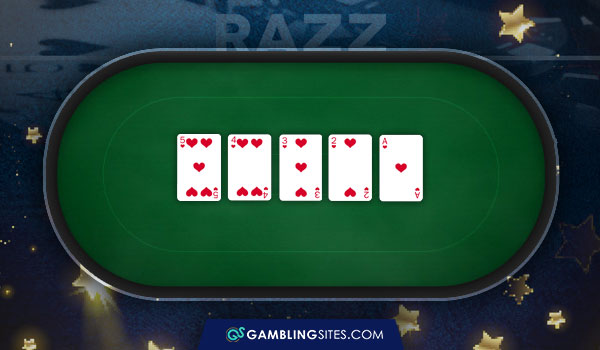
Straights and flushes are not relevant in lowball poker. If two players have the same highest low card, you look at whichever card is next in descending order.
You will need to adjust your strategy when you play Razz because you have to focus on low hands. It is the opposite of how you would play Hold ‘Em or Omaha.
Our Razz guide will help you understand how to modify your strategy based on the format of the game.
Five-Card Draw
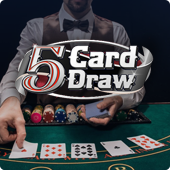
The last of the main three different kinds of poker is draw poker. Five-card draw is the most popular variant in this category.
Five-card poker is prevalent in home games and online, but it is not typically available in land-based poker rooms.
It is a straightforward game, so it is perfect for beginner poker players. The game needs to be limited to six players, so you have enough cards for each player to draw.
Some five-card draw games require players to pay an ante to start the game. Other variations use the small blind and big blind structures. You can play fixed-limit or no-limit five-card draw.
After the blinds or antes have been posted, the dealer will deal five cards to each player. Then players will complete the first round of bets based on the cards in their hand.
Before the next betting round, players will have a chance to discard some of their cards in exchange for new cards. You can keep or trade as many cards as you want, up to five.
The final betting round occurs after all players have had a chance to draw. Whoever has the best five-card hand wins.
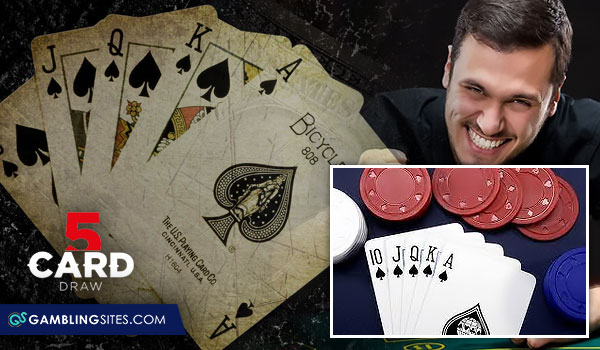
When you play five-card stud, you cannot see any of the cards the other players have in their hands. Therefore, you cannot use the same strategies in five-card draw as you do in other poker games.
You can use the number of cards that another player draws to predict what kind of cards they might have.
Our guide to five-card draw gives you some more tips about how to play the game and how to interpret other players’ actions.
More Variations of Poker
We have only scratched the surface with some of the most popular poker variations. Here is an introduction to a few other games that are also available.
- Crazy Pineapple – This game is a Texas Hold ‘Em variation that starts with each player getting three cards. Each player must discard one card after the flop.
- 2-7 Triple Draw – Also known as Deuce-Seven, this is both a draw poker and lowball variation. The best hand in 2-7 is 2,3,4,5 and 7. You have three chances to draw and four betting rounds.
- Badugi – Badugi is a Korean lowball poker game. To get a Badugi is to get four cards with different values and different suits, with no pairs. Because the lowest cards win, Ace-2-3-4 non-suited is the best hand in Badugi.
- Chinese Poker – Each player gets thirteen cards in Chinese poker. You have to create two five-card hands and a three-card hand. The three-card hand must be your worst hand. Chinese poker uses a complex point value scoring system instead of betting rounds, so it is easier to play with only two people.
These games prove just how varied poker can be. Many games have similar characteristics, but others are entirely different. The thing they all have in common is the use of standard poker hands.
Because these variations of poker are not as popular, they may be difficult to find in a land-based poker room. However, online poker variants include almost any game you can think of, including these.
Mixed Poker Games
Once you have gotten the hang of a few poker variations, you can challenge yourself by exploring mixed poker games.
As the name suggests, mixed poker games mix together several different poker forms. They can include between two and ten different games of poker.
Here are some of the most common mixed poker combinations.
HORSE

HORSE is one of the most popular mixed poker formats. It includes these poker variations played in this particular order.
- Hold ‘Em
- Omaha Hi/Lo
- Razz
- Seven-card Stud
- Seven-card Stud Eight or better
Many professional players believe HORSE is the perfect combination to test a player’s skill level. That is one reason the World Series of Poker added a $50,000 HORSE tournament to the series in 2006.
HORSE is the fundamental mixed poker game. Many other mixed variants are based on HORSE, with a few games added or removed.
For example, you can play CHORSE, which is HORSE that starts with a game of Crazy Pineapple. HOSE is another variation that takes out Razz but includes the other four games.
HA
HA is a combination of Texas Hold ‘Em and Omaha High. In this case, both games use a pot-limit format.
Because there are many similarities between Hold ‘Em and Omaha, this combination is the perfect mixed poker game for players who are just starting to play mixed games.
Playing similar games with the same betting structure will help new players adjust to the practice of switching between variants without getting overwhelmed.
HO
Once you have conquered HA, your next step should be to try HO. It is again a combination of Texas Hold ‘Em and Omaha.
This mixed poker format includes the Hi/Lo variant of Omaha. Hi/Lo is just different enough to add a new challenge.
HOE
Another HORSE variation is HOE. It includes Hold ‘Em, Omaha, and Seven-card Stud Eights or Better.
You might be wondering what Eights or Better is. It is a Hi/Lo variation of seven-card stud. Similar to Omaha Hi/Lo, the pot gets split between the highest and lowest hands.
It is called Eights or Better because the low hand is any hand with an 8 or lower. If there is no qualifying low hand, the high hand gets the entire pot.
Eight-Game
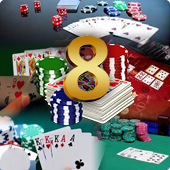
Of course, Eight-game is a mixed poker game that incorporates eight variants. Here are the games included.
- Fixed-limit 2-7 Triple Draw
- Fixed-limit Texas Hold ‘Em
- Fixed-limit Omaha Hi/Lo Eight or Better
- Razz
- Fixed-limit Seven-Card Stud
- Fixed-limit Seven-Card Stud Eight or Better
- No-Limit Texas Hold ‘Em
- Pot-limit Omaha
This combination can be incredibly challenging because you have to play different variations with multiple poker game types.
It is challenging to keep track of the different rules and various betting structures. This can lead to easy mistakes where you misbet or misplay a hand because you forgot which game you’re playing.
Quick Tips for Playing Mixed Poker Games
These are just a few examples of the combinations that are possible with mixed poker games.
When you play mixed poker games during a tournament, the variant typically changes at the end of each blind level. If you are playing a cash game, you can switch variants after a specific number of hands.
Mixed poker games are incredibly challenging because you have to constantly modify your strategy and keep track of which game you are playing.
For example, if you are playing Razz, your goal is to get the lowest hand possible. Right after that, you switch to playing seven-card stud, which requires a high hand.
Keeping track of the game you are playing is crucial. Here are a few other strategy tips that can help you master mixed poker games.

- Every player has strong and weak games. Know which games you excel at and which variants you struggle with. Play aggressively on your strong games and be more conservative during your weak games.
- Pay attention to how your opponents change their habits during each game. They have strong and weak games, too. You can take advantage of their weaknesses if you can figure out which variant it is.
- Make sure you have played a few hands of each variant before playing it in a mixed format. You don’t want your first exposure to the game to be during a mixed game.
If you are interested in finding out about additional mixed poker games and more strategy tips, check out our mixed poker games page.
Other Poker Games and Formats
A few new types of online poker games have gained popularity in the last decade or so.
We want to highlight these variants because they are very popular, but should be considered separate from the more traditional kinds of poker games.
Short Deck Poker
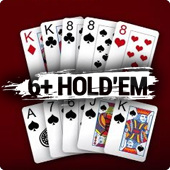
Short deck poker, or 6+ Hold ‘Em, is a Texas Hold ‘Em variation that started in Asian casinos in 2014. The rules are exactly the same as Hold ‘Em, but there is one significant difference.
Before the game starts, all of the 2’s, 3’s, 4’s, and 5’s get removed from the deck. So instead of a standard 52-card deck, you have to play with only 36 cards.
Besides a low ace, the six is the lowest card in 6+ Hold ‘Em.
Aces are more valuable when you play short deck poker. They can be used as a high card, a low card, or to make up the low and high ends of a straight.
Because the deck has been reduced, the mathematical odds of each hand changes. Here are a few examples so you can see what we mean.
- It is more difficult to get a three-of-a-kind than a straight with a short deck.
- The odds of getting a flush are particularly affected. When you play with a full deck, there are eleven cards for each suit. When you play with a short deck, there are only seven.
- It is easier to get a full house than a flush because so many cards of each suit get taken out.
Some poker rooms modify the hand rankings based on the reduced number of cards. Other poker rooms use the same rankings as traditional Hold ‘Em. Make sure you know the rankings before you start playing.
Short deck poker is a unique twist on classic Texas Hold ‘Em. It is an excellent way to challenge yourself because it requires different strategies based on the cards available.
You can play 6+ Hold ‘Em online, but it is not available on every site. Most land-based poker rooms do not offer short deck games outside of special occasions, like a tournament event.
Speed Poker

Speed poker has multiple names, including rush or zone poker. This variant is unique because it is only available online, and it can be combined with any other kinds of poker games.
You can play speed Hold ‘Em, or speed Omaha, or speed Razz. It is available in both tournaments and cash games. All of the rules are the same, but speed variants are usually small-stakes games.
The only other difference is what happens when you fold. Instead of waiting for the other players to play out the hand, speed poker automatically takes you to a new table so you can keep playing.
That way, if you fold pre-flop, you don’t have to wait for the other players to cycle through three more betting rounds.
Speed poker also includes a fast fold option. So if you know you are going to fold, you don’t have to wait for your turn before getting out of the game.
The benefit of speed poker is that it allows you to play way more hands in the same amount of time. However, many players are more inclined to fold, so you might not see as much post-flop action as you like.
For more information about speed poker, including the specific brands that are available from various online poker sites, check out our speed poker page.
Poker Cash Games vs. Tournaments
No matter which poker variant you decide to play, you need to consider whether you want to play it in a cash game or a tournament.
Every poker game is operated in one of these two formats. Many players enjoy both cash games and tournaments, some prefer one of the two formats. You should understand the differences between the two before you start playing.
Cash Games

When you play a cash game, the chips represent real cash value. So if you play a $1 chip, it is a $1 bet. That may seem obvious, but it is very different from how tournaments are played.
The poker room will set a minimum and maximum for the table, but cash games allow you to buy in for any amount between the table limits.
If you buy in at the minimum amount, the other players may have double or triple the amount of chips. Players with a higher bankroll can play more aggressively.
Cash games also allow players to buy in as many times as they want to. Online poker software will tell you how many chips another player has, but that doesn’t mean anything if they can afford to buy in again.
Here are a few other unique characteristics that poker cash games have.
- The blind levels will stay the same throughout the cash game. Tournaments increase the blind levels periodically.
- You can leave a cash game at any time. When you quit a cash game, you can exchange your chips for their cash value.
- Cash games are single-table games, so you are only competing against the players at the table with you.
- If it is a full-ring game, it will have nine players. Other games may have four or six players, or you can play heads-up.
The number of players you are competing against is a key point because it can drastically affect your strategy. This is because you will play with the same few players for the duration of the game – until someone decides to leave.
That means that you can get to know your opponents and their habits. The longer you play with them, the more you will be able to predict their next move.
If you play in a tournament, the opponents at each table will change after each round. You may become familiar with a few players, but not as well as you can during a cash game.
If you’re interested in learning more about poker cash games, then check out the following guide.
Poker Tournaments

Tournaments are fundamentally different from cash games because they start with a level playing field. Every player pays the same buy-in and gets the same number of chips to start with.
The prize pool incorporates everyone’s buy-ins, minus the fee for the poker room.
Instead of winning based on the number of chips in your hand, you will earn a portion of the prize pool based on your final rank in the tournament.
You cannot leave a tournament until it has ended without forfeiting your chips. Because of this structure, the chips do not have any real money value until the tournament has ended.
During the game, it is better to think in terms of the number of big blinds each player has. That is an indication of how well each player is doing or how close that player is to getting knocked out.
The different forms of poker tournaments allow players to modify their strategy based on the stacks available.
There are dozens of tournament formats of poker games, so the exact rules will depend on the type of tourney you join. You can learn more about the different formats and variations tournaments use by reading our guide.
For now, here are a few different examples of factors that depend on the tournament you join.
- Number of Blinds – Regular tournaments typically allow players to start with enough chips for 50-100 big blinds. Deep stack tournaments offer 200 big blinds, and small stacks tournaments start with 25 or fewer.
- Blind Speed – Tournaments increase the blinds based on a pre-determined schedule. Each blind level may last between 3-60 minutes, depending on the type of tournament.
- Re-buys and Add-ons – Some tournaments allow players to buy in again or purchase additional chips during the early stages of the tournament.
Another thing that is different about tournaments is that they are typically open to any number of players. As long as you can pay the buy-in, you can join the tournament.
The only exception is online sit-and-go tournaments that have a maximum number of players.
Now that you know a little about how cash games and tournaments work let’s see how they compare in specific detail.
| Formats and Features | Cash Games | Tournaments |
| Number of Players | Typically 2-9 | Typically Unlimited |
| Rake vs. Fee | The poker room takes a rake from each pot | The poker room takes a fee that is added to the buy-in. Example; $500+$25= $500 to the prize pool and $25 to the poker room |
| Blind Levels | Remain the same throughout the game | Increase every 3-60 minutes, depending on the tournament structure |
| Availability and Schedule | Available any time, you can come and go as you please | Most tournaments have a scheduled start time (other than sit and go’s). You can only leave the tournament when you run out of chips |
| Chips Strategy | Chips are based on real-world value. ICM is not used. | Chips are based on the number of big blinds in the stack relative to the buy-in amount. ICM (Independent Chip Model) is crucial to strategy |
Betting Limits and Forced Bets in Poker Games
In addition to the different rules, poker games also have multiple betting structures that can impact how the game is played.
Some poker game types can be played with any betting limit, but other poker variants require certain limits.
For example, Texas Hold ‘Em can be played in a no-limit, pot-limit, or fixed-limit format. Seven-card stud is typically played with fixed limits.
Proficient players know how to modify their betting strategy based on the betting limit they are playing. The best way to learn how to do that is to play the same poker variant with different betting limits.
You need to understand how these betting structures are different, so you’re making the correct bets and optimizing your strategy for whatever games you’re playing.
(Fixed) Limit Poker
With fixed limit games everything from the amount you can bet or raise – if you can do either at all – is predetermined. There is a limit to both the amount you can bet or raise, and how many bets or raises can be made per round.
This is how limit games work:
Preflop and on the flop, you’ll be able to bet and raise the small blind – in our case that’d be $1. And in many games the max number of times you can raise is 4. So, at most each person will put in $4.
On the turn and river (or later rounds in razz and stud), the big blind is doubled. In our case that’d be to $2. The 4 raises per round applies here too.
Limit holdem used to be a really popular game. That is, until no limit games were shown on TV. Now limit is mostly used in poker games like stud and razz. It’s one of the easiest betting formats to learn.
And because of the cap on every betting round, it’s a bit easier on the bankroll. That said, limit games are the hardest to master.
For one thing, there’s no room to bluff. Since you’re only able to make a bet the size of the big blind, there’s always odds to call. And it’s almost always correct to do so. In fact, experts say a common mistake is to fold too much.
(This is the opposite of no limit poker where players don’t fold enough.)
Another HUGE mistake is slow playing.
Since you’re only able to bet so much and so many times per round – and the fact that every player will have odds to call to draw – slow playing only means you’re missing out on LOTS of value. You really need to maximize what you win when you have the best hand. This also helps make up for the times you draw to better hands (correctly) and lose.
The bottom line is fixed poker is more or less a passive math game rather than an aggressive game that often relies on guts and brute force – like no limit games often do.
No Limit Poker
This is arguably the most popular type of poker today. This is what you mostly see on TV. The exciting part is when you see someone say they’re “all in”. It’s exciting because they’re willing to put all their chips – sometimes their tournament life – on the line.
This encourages a brute force style of strategy that many players use. Very much UNLIKE fixed limit poker. Not only that, but there are no limits as to how much you can bet. So long as you meet the blinds with your bets and raises, you can do whatever you want.
Pot Limit Poker
This is sort of a mix between fixed and no limit poker. You have a cap on how much you can bet, but you’re only limited by the size of the pot. As you can probably imagine, once you make a few bets and raises – or get a few streets in – the pot is big enough where you can go all in.
(It’s important to point out that you don’t have to “pot it” every time you raise. You can raise anywhere from the minimum (double the last bet/raise) to the size of the pot. Anywhere in between that is fine.)
Strategy is somewhere in the middle, too.
Experts say that someone with a good handle of both fixed and no limit poker can do well in pot limit games.
You want to be someone that can play the odds, bet for value (real important early on to build a bigger pot later), and still play the player.
It’s a challenging, yet profitable betting limit for players up to the challenge of mastering it.
Cap Limit Poker
The general idea with cap limit games is there’s a limit to how much money you can put into a hand. This is relative to big blinds, and is often between 20 and 30. Once you’ve reached the cap it’s treated as if you’re “all in.”
Experts say this can lead to more lively and aggressive games since your risk is capped more so than no limit and pot limit. Since you can only lose so much, it probably encourages more ‘screw it, let’s run it’ type moments.
Spread Limit Poker
Spread limit games are similar to fixed limit poker.
You’ll have a range or spread – say $2 to $5 – that you can choose from for your bets and raises.
It’s not a popular betting limit, based on the fact that we don’t see it online (much) and when you Google the phrase the results are scarce. But these games do run.
One of the biggest tips for playing spread poker is to be less transparent with your bets.
Beginners tend to make the mistake of betting the top of the spread with their best hands and at the bottom with weaker hands. But anyone paying attention will spot this.
So, you want to be more aware of how you size your bets relative to the strength of your hand.
Other than that, since this is so much like limit poker we’d recommend following those strategies. Bet for value, fold a little less often compared to pot and no limit poker, and bluff less.
Forced Bets
Poker would be no fun if no one ever put money into the pot. Forced bets prevent that because they are mandatory wagers that guarantee at least two players bet in every hand. Forced bets encourage action.
There are different kinds of forced bets that are used in specific poker variants. Each poker variation uses one or more of the following options.

- Ante – All players have to pay an ante before the hand gets dealt. If you don’t pay the ante, you can’t play that hand. Stud poker games typically have antes, but some Hold ‘Em games also have an ante in cash games or the later stages of a tourney.
- Blinds – When a game uses blinds, two players must pay the blind before the cards get dealt. Each player takes turns paying the small blind and the big blind, rotating from the dealer’s left. The big blind is the minimum bet, and the small blind is typically half of that amount. Blinds are primarily used in community card games.
- Straddle Bet – Straddle bets are used in games with a blind structure. A straddle bet is when a player buys the big blind before the cards are dealt, which doubles the stakes for that round. Some poker rooms have rules about when you can play a straddle bet based on your position at the table.
- Bring-in – Stud games use a bring-in forced bet. The player with the weakest hand starts the betting by playing the bring-in. It is usually the same amount as the ante or a percentage of the minimum bet.
- Complete – If a game uses a bring-in bet, it will also have a complete. The next player that wants to raise must complete the bet by raising the minimum bet amount minus the bring-in.
- Big Bet/Small Bet – Stud games may also use the terms big bet and small bet. These bets refer to the betting limits that are in place during certain betting rounds. For example, the small bet is typically the minimum bet during the first betting round and the 4th street. The big bet would be used during the fifth, sixth, and seventh streets.
The forced bets that are used affect the game’s dynamics. For example, poker tournaments increase the blind levels every few minutes so that players are forced to play, or risk being blinded out.
Ante bets force all players to pay to play each hand. This encourages action because the antes from six or nine players can create a significant pot of “dead money” to be won BEFORE the cards are even dealt.
Understanding how forced bets affect the game is a crucial part of poker strategy.
Choosing Which Poker Game to Play
Now that you know about all of the different types of poker games, you need to decide which one you want to play.
That decision is more complex than simply choosing between Texas Hold ‘Em and Omaha or Razz. Each game has different variants, betting limits, and formats. There is a lot to consider.
Here are the steps you should follow to decide which poker game to play.

- First, decide which game you want to play. If you choose Omaha or Seven-Card Stud, you need to decide if you want to play the regular version or the Hi/Lo split-pot variant.
- Next, you need to decide if you want to play in a cash game or a tournament. Remember that the format of the game will affect the number of players, how the blinds work, and how the chips are valued.
- Then, you need to determine the betting limits. You can choose between no-limit, fixed-limit, pot-limit, spread, and cap. Make sure the poker room you are using offers the betting limit structure you want to play.
The forced bets depend on the variant you are playing, so you don’t have much of a choice about that. Just be aware of how the forced bets will impact your strategy.
Fortunately, there is no right or wrong answer. Each game and poker format offers a unique experience.
The more you play different types of online poker games, the better you will be at modifying your strategy and knowing what to expect from each variant.
If you are unsure about playing a specific type of poker game, you can play demo versions online for free. That way, you can practice without risking money.
Here is an overview of all the different options available for the top poker variants we covered.
| Game | Variants Available | Cash vs. Tournament Availability | Betting Limits Available | Typical Forced Bets |
| Texas Hold ‘Em | Hold’ Em, Crazy Pineapple, 6+ Hold ‘Em | Available in both cash games and tournaments. Some variants may only be available in one format. | No-Limit, Pot-Limit, Fixed-Limit | Blinds, Antes, Straddle |
| Omaha | Omaha High, Omaha Hi/Lo, Omaha Eights or Better | Typically available in both cash games and tournaments. | Pot-Limit (most common), Fixed-Limit, No-Limit | Blinds, Antes, Straddle |
| Seven-Card Stud | Seven-card Stud, Seven-card Stud Hi/Lo Eights or Better | Typically available in both cash games and tournaments. | Fixed-Limit (most common), Pot-Limit | Ante, Bring-in, Small Bet/Big Bet |
| Razz | Razz | Most often played in tournaments or part of mixed games. | Fixed-Limit (most common), Pot-Limit | Ante, Bring-in, Small Bet/Big Bet |
| Five-Card Draw | Draw poker games such as Deuce-Seven Triple Draw | Typically available in both cash games and tournaments. | No-Limit, Pot-Limit, Fixed-Limit | Blinds |
Where to Play Poker Games Online
Your options for playing a variety of poker games depend on the poker room you use to play. Some online poker sites only offer popular variants, while others have a limited tournament schedule.
Here are our recommendations for the best online poker sites, where you can play several different forms of poker.
How We Rate

Safety & Security
You should be able to gamble online without fear. So we only recommend licensed sites that use the latest security and encryption techniques.

Bonuses
Maximize your bankroll with fantastic bonuses. Our recommended sites offer valuable bonuses with fair terms and conditions, including manageable wagering requirements.

Games & Betting
The best sites have the best wagering options. That’s why you will find extensive games and betting opportunities on our recommended sites.

Banking
Getting your money to and from your account shouldn’t be a hassle. We only recommend sites with a variety of convenient banking methods, including cryptocurrency and e-wallets.
The variety of games they offer is only one factor we consider before recommending a particular site. A poker room also has to have appropriate security measures and excellent promotions to make the cut.
One of the most crucial aspects of an online poker site is the amount of traffic they generate. Traffic refers to the number of players on a particular site at any given time.
You can’t play poker if you don’t have enough players to start a game. Some online poker rooms offer games for less popular variants, but they might not have enough traffic to actually start the game.
Site traffic fluctuates, so it is a good idea to join a few different poker sites. That way, if there are not enough players for a variant you want to play on one site, you can try another site.
You can find out more about the benefits of joining multiple poker sites and what to look for by checking out our guide to online poker sites.
Casino Poker Games
There are two other types of poker games we haven’t discussed yet. That is because casino poker games are very different from traditional poker.
When you play traditional poker, you compete against other players to win the pot. The poker room or casino only makes money by collecting a rake.
Casino poker games are different because you compete against the casino. All of these poker variants operate as a heads-up game where the other player is the dealer.
Here are a few examples of casino poker games that you may enjoy playing.

- Casino Hold ‘Em is a heads-up variant of Texas Hold ‘Em. The dealer must have a pair of fours or better to qualify. Instead of blinds, Casino Hold ‘Em uses antes and call bets.
- Pai Gow Poker is another casino poker game that incorporates aspects of the pai gow tile game. Players must create two poker hands from seven cards (one with five cards and the other with two cards.) This game allows players to take turns being the dealer.
- Caribbean Stud Poker is a variation of five-card stud where the players can only see one of the dealer’s cards before deciding whether to fold or call. The dealer must have an Ace-King or better to qualify.
- Mississippi Stud Poker is unique because you don’t have to compete against a house dealer. Instead, your poker hand is compared to a payout table. You earn a payout based on how strong your hand is.
- Let It Ride Poker is a variation of five-card stud. Players get three cards in their hand, and there are two community cards. Instead of raising your bet, you have two opportunities to withdraw portions of your bet.
- Three-card Poker is a heads-up game where the best three-card hand wins. Because there are only three cards in play, a straight flush is the best possible hand. You cannot have a full house or a royal flush in this variation. The dealer must qualify with a hand of queen high or better.
Video poker machines are also different from traditional poker. They are similar to five-card draw but, because they are electronic machines, there is no opponent. Instead, your losing hands go to the casino.
While these games do not qualify as traditional poker, they are another option you may enjoy. They use the same poker hand rankings as traditional poker, so you already know a little about how to play.
You can learn more about playing video poker in the following guide.
 75%
75% 80%
80%